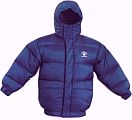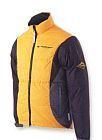Goose down winter jackets
We compiled a rundown on goose down winter jackets. Check out the benefits, and the disadvantages to see if these are suitable for you next ski journey.

Why choose a goose down winter jacket?
Due to their superior insulating properties, they retain heat well in the extreme winter conditions. High altitude climbers and ice caps travellers stand by these winter jackets.
What makes these winter jackets superior in insulation?
High quality goose down fill is the contributor to providing the insulation. The fine feather meshwork or lattice allows pockets of warm air to be trapped. This warm air cocoons your entire body, allowing you to retain heat. The water repelling or hydrophobic feather properties draw moisture away from your body, leaving only warm air molecules to keep you warm.
Are there limitations to goose down winter jackets ?
Like most products that are superior in one area, they may be sub-optimal in another, and these winter jackets are no exception. Their limitation is when precipitation is occurring in warmer weather.
The outer layering of these jackets is usually made out of Nylon, or treated Nylon blends. Nylon is porous to rain, hail and does not let your body breathe well. So in winter with temperatures higher than –15degC, the jacket may soak up, and loose it’s insulating properties. View down winter jackets, as great alternatives for skiing in freezing conditions, when the weather is optimal.
If goose down jackets are used on snow expeditions why are they not an ideal alternative for all skiers?
It all comes down to what weather conditions you are likely to ski in. If it’s freezing outside, rain turns to powder, jacket’s outer layer is cold, the snow flakes will not melt upon contact, and moisture will not penetrate the goose down, then your down jacket will do well. This assumes you are not perspiring underneath to the extent of soaking up in sweat. We believe they do best in minus 20degC.

How much goose down insulation is enough?
As almost all of the down jackets use external Nylon lining, the insulation becomes a function of the down-fill. As a rule of thumb we recommend these categories:
- 600 (euro rating scale) as an entry model for short snow expeditions
- 650 down fill for professionals, who undertake expeditions of prolonged durations
- 800 down-fill for extremely cold ski adventures in excess of minus 20degC.
If you have purchased down winter jackets with less down content, don’t despair as it is very easy to top it up at the cost of approx. U S $20.00.
What happens when my goose down jacket becomes soaked with rain?
If you feel the jacket is saturated with water, you will have a window to look for shelter.Ah.. just got a nudge from Aggie..rather than digging your shelter you may go back to the lodge instead. As the down-fill becomes soaked you will lose the entire insulating characteristics. Your toosh will get cold.
How do I wash my down winter jacket?
Instructions on labeling may be of help. Some harsh washing powders can strip the oily coating off the feathers, reducing it’s water repellency. Oxidizing, enzymatic type of action detergents may destroy the Nylon outer layers. Use gentler washing detergents.
Why are down winter jackets made out of Nylon outer?
There are four reasons we could put together:
- light weight
- good wind resistance
- durable and strong
- cheap to manufacture
Best way to transport down winter jackets?
Our tip, which will leave you with a good feeling, you may in fact sense you are on top of what technology offers, use a vacuum bag. Plug up that vacuum cleaner to the bag and you Goose down winter jacket shrinks to minimalist’s proportions. You can probably carry it as your hand luggage. The down–fill is the most compressible insulating fill on the market.
From goose down winter jackets back to the home page.






